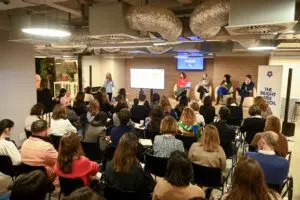At the recent Rencontres de l’innovation éditoriale, Mélusine Boon-Falleur (researcher at Sciences Po), Audrey Garric (Le Monde journalist) and Audrey Cerdan (Climate Editor-in-Chief at France TV) shared insights that point to both the opportunities and the pitfalls.
The challenge of complexity: making it accessible without oversimplifying
One of the greatest barriers to public understanding is the inherent complexity of the issues at stake.
Take the IPCC’s climate reports. These science-heavy documents, dense with data and projections, are critical for understanding climate change — yet often inaccessible to the wider public. The question is: how do you make them digestible without distorting their meaning?
The answer lies in creating multiple points of entry: infographics, key figures, relatable metaphors, and the blending of perspectives. Language matters — it must convey the seriousness of the situation while avoiding technical jargon.
Rather than referring to “1.5°C or 2°C scenarios”, it can be more evocative to say “a summer with one month of heatwave” or “two months’ worth of rain in a single day” rather than “20mm”. Such reframing makes the stakes tangible — and emotionally resonant.
However, accessibility must not slip into oversimplification. Maintaining conditional phrasing, for example, helps retain scientific rigour and avoids fuelling climate scepticism.
Long-term issues in a short-term world
Another tension lies in reconciling the short attention span of the news cycle with the long arc of future challenges. Climate change unfolds over decades or even centuries, while media agendas are driven by immediacy.
How can the public grasp that decisions taken today will shape the lives of generations to come?
France TV addressed this with its “Météo Climat” bulletin, combining daily weather forecasts with climate context. By changing the reference period for “seasonal norms” — from 1991–2020 to 1970–2000 — the shift becomes tangible. This approach brings climate change into people’s daily lives, connecting it to concrete events such as nursery closures in summer or the disappearance of certain cheeses.
Cognitive science shows that attention is best captured by issues that feel personal and relevant. Anchoring future scenarios in the present — and in the familiar — increases the chances of real engagement.
Fiction as a tool — and its limits
Fiction can be a powerful way to speak about the future. Projects like Futures in transition — an Ademe initiative — imagine what a carbon-neutral France could look like.
Businesses are exploring the same terrain: for Suricats Consulting, for example, we developed a design fiction report projecting to 2050, envisioning a France that has “succeeded” in its transition.
Fiction can make the distant tangible. It can explore extremes, spark emotion, and stimulate imagination. But to be credible, it must be grounded in robust science — and steer clear of both fear-mongering and naïve optimism.
Shifting the lens: broadening the conversation
To talk meaningfully about the future, we must break out of familiar narratives. Reaching wider audiences means going beyond purely ecological framing. Themes such as security, migration, and tradition can provide entry points for those less attuned to environmental issues.
Trusted voices — firefighters, the armed forces — can convey messages about how climate change affects professions and daily life.
Equally, the conversation must not be limited to risks. People are often well aware of the dangers, but far less informed about solutions. Linking the two avoids fatalism and inspires action.
Are we ready to talk about the future?
The answer is… partly. The tools exist — education, contextualisation, fiction — but they must be applied thoughtfully. Scientists, journalists and creatives have a shared responsibility: to make future challenges accessible, concrete, and actionable.

